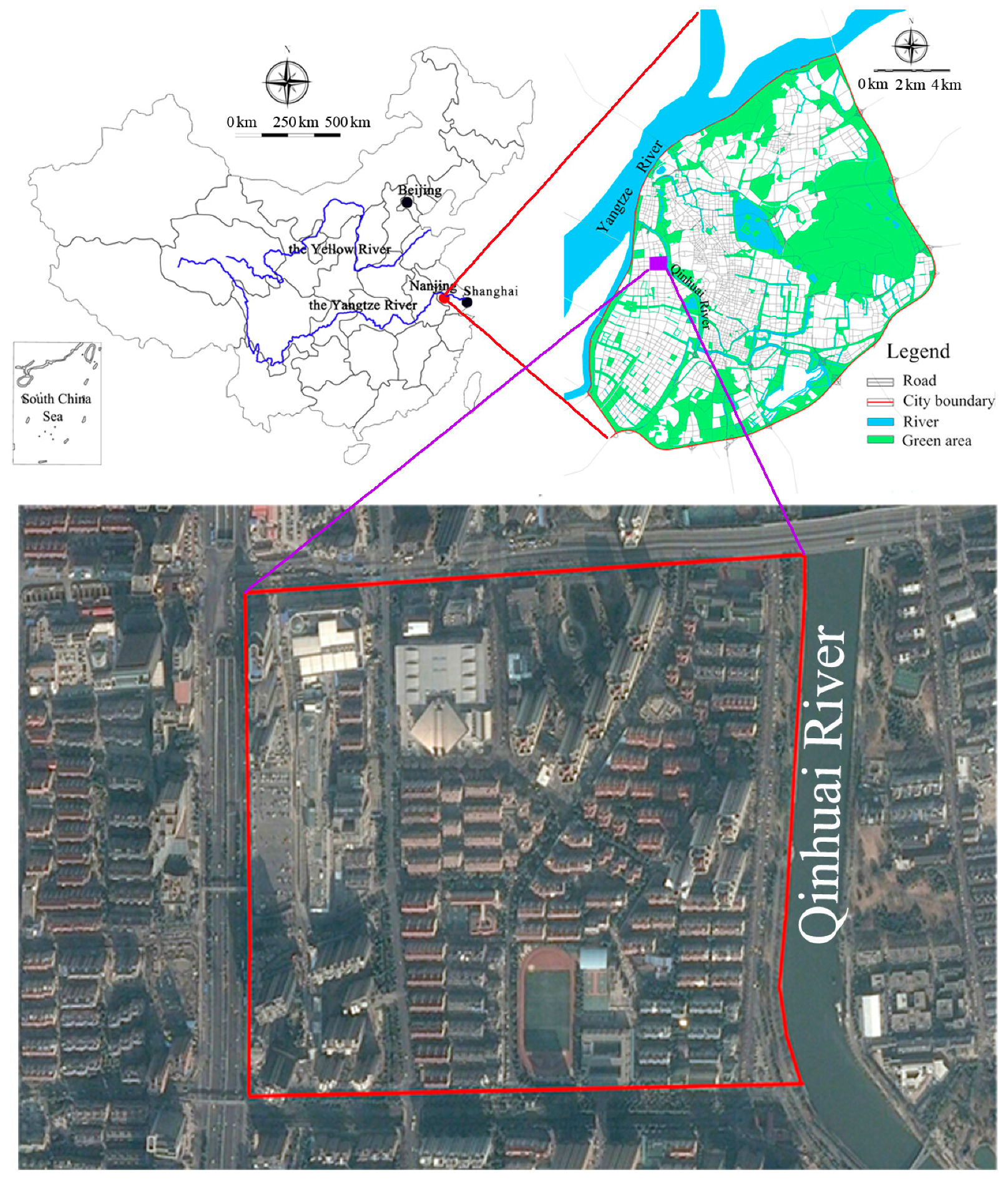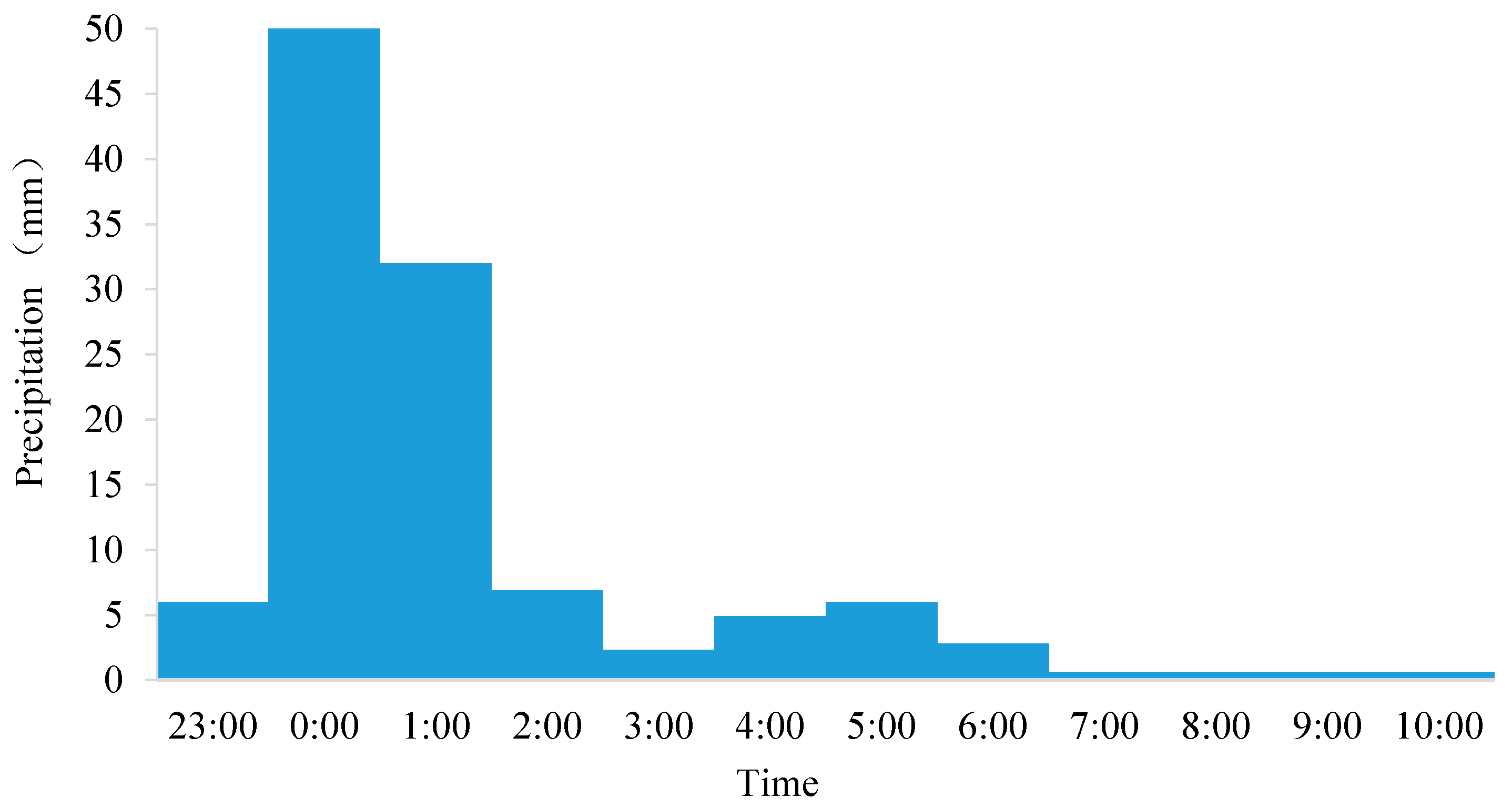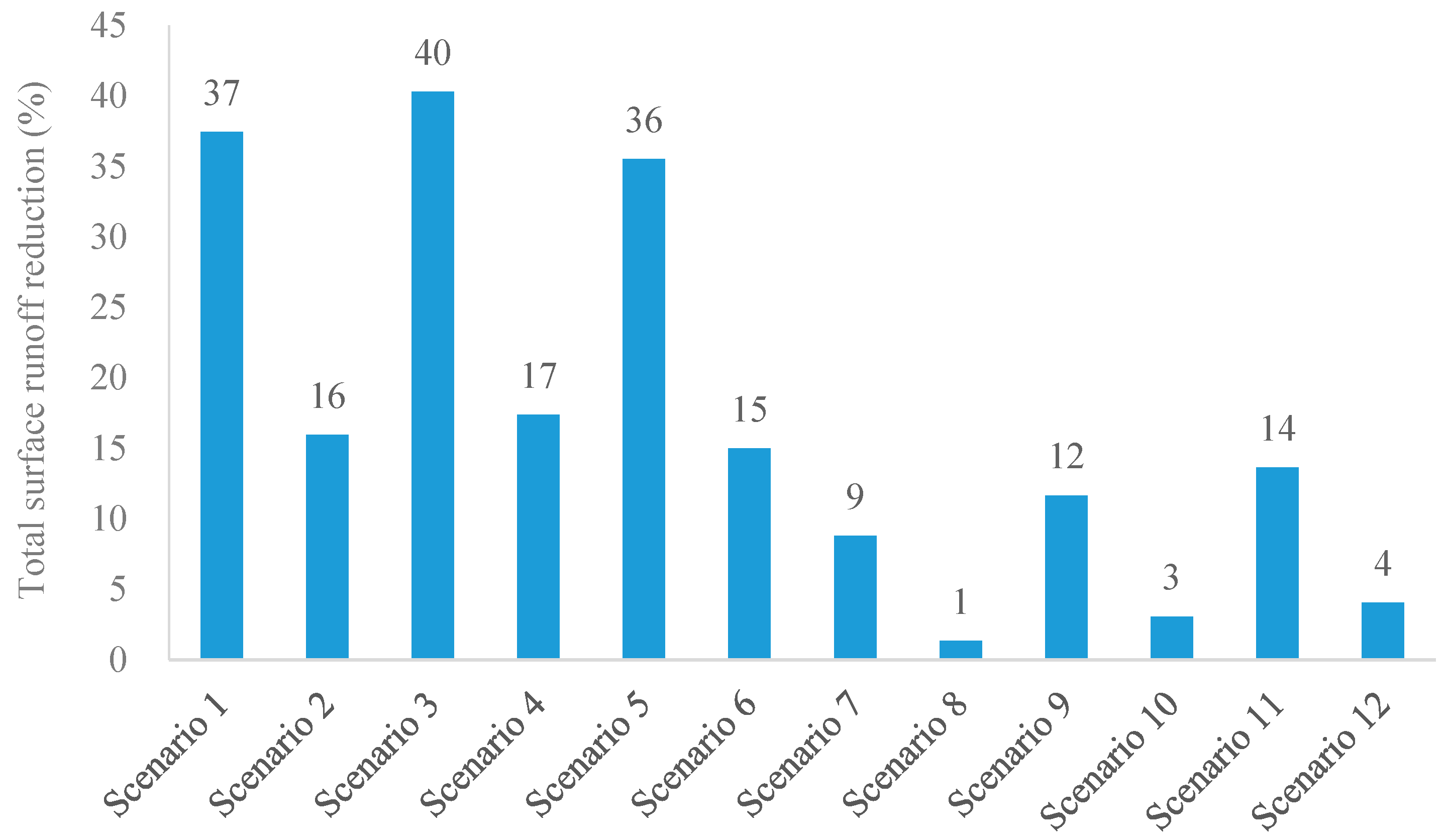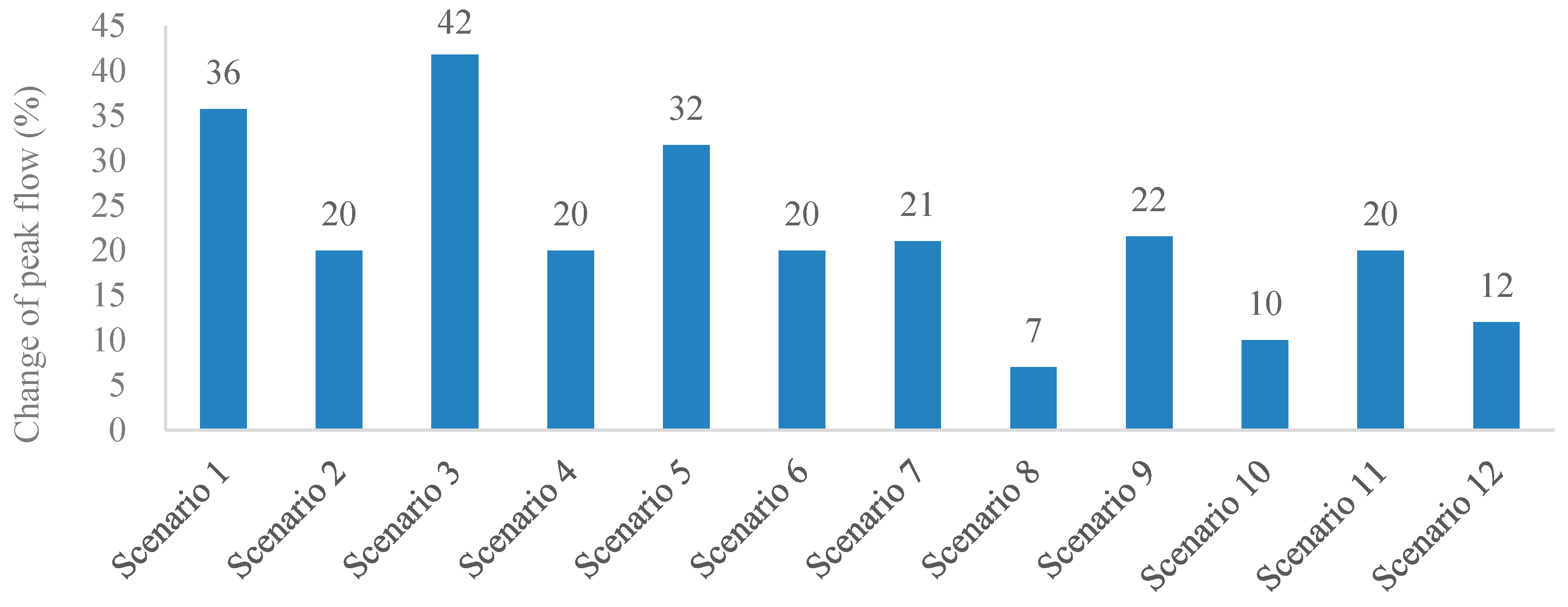Flood Mitigation by Permeable Pavements in Chinese Sponge City Construction
Abstract
:1. Introduction
2. Materials and Methods
2.1. Research Site and Data
2.2. Flow Calculation
2.2.1. Impervious Module
2.2.2. Pervious Module
2.3. Permeable Pavement Scenarios and Model Setting
3. Results and Discussion
3.1. Effectiveness of Permeable Pavements on Flood Mitigation
3.2. Impact of Clogging on the Performance of Permeable Pavements
3.3. Impact of Initial Water Content on the Performance of Permeable Pavements
3.4. Implications and Limitations
4. Conclusions
- (1)
- Permeable pavements reduced surface runoff by 1–40% and peak flow by 7–43% in a 12-h storm event with rainfall of 113.8 mm.
- (2)
- The hydrological performance of permeable pavements varied widely depending upon whether their function was fully applied. Without the impact of clogging, PC showed the best performance, followed by PA and PICP.
- (3)
- Clogging reduced the hydrological performance of permeable pavements. PICP was the least prone to being clogged, followed by PC and PA. PA, PC and PICP reduced the total surface runoff by 77–92%, 71–82% and 62–73%, respectively; and reduced peak flow by 41–65%, 48–50% and 37–40%, respectively.
- (4)
- The hydrological performance of permeable pavements decreased with increasing initial water content. Compared to permeable pavements without initial water content, the effectiveness of the cases with 50% initial water content decreased the total runoff by 57–85% and peak flow by 37–67%, respectively.
Acknowledgments
Author Contributions
Conflicts of Interest
References
- Cheng, X. Changes of Flood Control Situations and Adjustments of Flood Management Strategies in China. Water Int. 2005, 30, 108–113. [Google Scholar] [CrossRef]
- Moore, S. The political economy of flood management reform in China. Int. J. Water Resour. Dev. 2017, 1–12. [Google Scholar] [CrossRef]
- Zhu, Z.; Chen, X. Evaluating the Effects of Low Impact Development Practices on Urban Flooding under Different Rainfall Intensities. Water 2017, 9, 548. [Google Scholar] [CrossRef]
- Hu, M.; Sayama, T.; Duan, W.; Takara, K.; He, B.; Luo, P. Assessment of hydrological extremes in the Kamo River Basin, Japan. Hydrol. Sci. J. 2017, 62, 1255–1265. [Google Scholar] [CrossRef]
- Piao, S.; Ciais, P.; Huang, Y.; Shen, Z.; Peng, S.; Li, J.; Ding, Y. The impacts of climate change on water resources and agriculture in China. Nature 2010, 467, 43–51. [Google Scholar] [CrossRef] [PubMed]
- Yang, H.; Flower, R.J.; Thompson, J.R. Sustaining China’s water resources. Science 2013, 339, 141. [Google Scholar] [CrossRef] [PubMed]
- Sayama, T.; Ozawa, G.; Kawakami, T.; Nabesaka, S.; Fukami, K. Rainfall-runoff-inundation analysis of the 2010 Pakistan flood in the Kabul River basin. Hydrol. Sci. J. 2012, 57, 298–312. [Google Scholar] [CrossRef]
- Liu, H.; Jia, Y.; Niu, C. “Sponge city” concept helps solve China’s urban water problems. Environ. Earth Sci. 2017, 76, 473. [Google Scholar] [CrossRef]
- Xia, J.; Zhang, Y.; Xiong, L.; He, S.; Wang, L.; Yu, Z. Opportunities and challenges of the Sponge City construction related to urban water issues in China. Sci. China Earth Sci. 2017, 60, 652–658. [Google Scholar] [CrossRef]
- Jiang, Y.; Zevenbergen, C.; Fu, D. Can “Sponge Cities” Mitigate China’s Increased Occurrences of Urban Flooding. Aquademia Water Environ. Technol. 2017, 1, 3. [Google Scholar] [CrossRef]
- Hu, M.; Sayama, T.; Zhang, X.; Tanaka, K.; Takara, K.; Yang, H. Evaluation of low impact development approach for mitigating flood inundation at a watershed scale in China. J. Environ. Manag. 2017, 193, 430–438. [Google Scholar] [CrossRef] [PubMed]
- Chinese Ministry of Housing and Urban Rural Development (MHURD). Preliminary Technical Guidance for Sponge City Construction—Low Impact Development Rainwater System Construction; MHURD: Beijing, China, 2014; (In Chinese).
- Brunetti, G.; Šimůnek, J.; Piro, P. A comprehensive numerical analysis of the hydraulic behavior of a permeable pavement. J. Hydrol. 2016, 540, 1146–1161. [Google Scholar] [CrossRef]
- Fletcher, T.D.; Shuster, W.; Hunt, W.F.; Ashley, R.; Butler, D.; Arthur, S.; Viklander, M. SUDS, LID, BMPs, WSUD and more—The evolution and application of terminology surrounding urban drainage. Urban Water J. 2015, 12, 525–542. [Google Scholar] [CrossRef]
- McGrane, S.J. Impacts of urbanisation on hydrological and water quality dynamics, and urban water management: A review. Hydrol. Sci. J. 2016, 61, 2295–2311. [Google Scholar] [CrossRef]
- Pyke, C.; Warren, M.P.; Johnson, T.; LaGro, J.; Scharfenberg, J.; Groth, P.; Main, E. Assessment of low impact development for managing stormwater with changing precipitation due to climate change. Landsc. Urban Plan. 2011, 103, 166–173. [Google Scholar] [CrossRef]
- Scholz, M.; Grabowiecki, P. Review of permeable pavement systems. Build. Environ. 2007, 42, 3830–3836. [Google Scholar] [CrossRef]
- Zhang, X.; Guo, X.; Hu, M. Hydrological effect of typical low impact development approaches in a residential district. Nat. Hazards 2016, 80, 389–400. [Google Scholar] [CrossRef]
- Damodaram, C.; Giacomoni, M.H.; Khedun, C.P.; Holmes, H.; Ryan, A.; Saour, W.; Zechman, E.M. Simulation of Combined Best Management Practices and Low Impact Development for Sustainable Stormwater Management. J. Am. Water Resour. Assoc. 2010, 46, 907–918. [Google Scholar] [CrossRef]
- Gao, C.; Liu, J.; Zhu, J.; Wang, Z.W. Review of Current Research on Urban Low-impact Development Practices. Res. J. Chem. Environ. 2013, 17, 209–214. [Google Scholar]
- Huang, J.J.; Li, Y.; Niu, S.; Zhou, S.H. Assessing the performances of low impact development alternatives by long-term simulation for a semi-arid area in Tianjin, northern China. Water Sci. Technol. 2014, 70, 1740–1745. [Google Scholar] [CrossRef] [PubMed]
- Qin, H.P.; Li, Z.X.; Fu, G.T. The effects of low impact development on urban flooding under different rainfall characteristics. J. Environ. Manag. 2013, 129, 577–585. [Google Scholar] [CrossRef] [PubMed] [Green Version]
- Xie, J.; Wu, C.; Li, H.; Chen, G. Study on Storm-Water Management of Grassed Swales and Permeable Pavement Based on SWMM. Water 2017, 9, 840. [Google Scholar] [CrossRef]
- Zhang, X.; Hu, M.; Chen, G.; Xu, Y. Urban Rainwater Utilization and its Role in Mitigating Urban Waterlogging Problems—A Case Study in Nanjing, China. Water Resour. Manag. 2012, 26, 3757–3766. [Google Scholar] [CrossRef]
- Zhang, X.Q.; Hu, M.C. Effectiveness of Rainwater Harvesting in Runoff Volume Reduction in a Planned Industrial Park, China. Water Resour. Manag. 2014, 28, 671–682. [Google Scholar] [CrossRef]
- Fassman, E.A.; Blackbourn, S. Urban runoff mitigation by a permeable pavement system over impermeable soils. J. Hydrol. Eng. 2010, 15, 475–485. [Google Scholar] [CrossRef]
- Kamali, M.; Delkash, M.; Tajrishy, M. Evaluation of permeable pavement responses to urban surface runoff. J. Environ. Manag. 2017, 187, 43–53. [Google Scholar] [CrossRef] [PubMed]
- Collins, K.A.; Hunt, W.F.; Hathaway, J.M. Hydrologic comparison of four types of permeable pavement and standard asphalt in eastern North Carolina. J. Hydrol. Eng. 2008, 13, 1146–1157. [Google Scholar] [CrossRef]
- Kumar, K.; Kozak, J.; Hundal, L.; Cox, A.; Zhang, H.; Granato, T. In-situ infiltration performance of different permeable pavements in a employee used parking lot—A four-year study. J. Environ. Manag. 2016, 167, 8–14. [Google Scholar] [CrossRef] [PubMed]
- Bean, E.Z.; Hunt, W.F.; Bidelspach, D.A. Field survey of permeable pavement surface infiltration rates. J. Irrig. Drain. Eng. 2007, 133, 249–255. [Google Scholar] [CrossRef]
- Boogaard, F.; Lucke, T.; van de Giesen, N.; van de Ven, F. Evaluating the Infiltration Performance of Eight Dutch Permeable Pavements Using a New Full-Scale Infiltration Testing Method. Water 2014, 6, 2070–2083. [Google Scholar] [CrossRef]
- Jiang, W.; Sha, A.; Xiao, J.; Li, Y.; Huang, Y. Experimental study on filtration effect and mechanism of pavement runoff in permeable asphalt pavement. Constr. Build. Mater. 2015, 100, 102–110. [Google Scholar] [CrossRef]
- Chandrappa, A.K.; Biligiri, K.P. Comprehensive investigation of permeability characteristics of pervious concrete: A hydrodynamic approach. Constr. Build. Mater. 2016, 123, 627–637. [Google Scholar] [CrossRef]
- Turco, M.; Kodešová, R.; Brunetti, G.; Nikodem, A.; Fér, M.; Piroa, P. Unsaturated hydraulic behaviour of a permeable pavement: Laboratory investigation and numerical analysis by using the HYDRUS-2D model. J. Hydrol. 2017, 554, 780–791. [Google Scholar] [CrossRef]
- Huang, J.; He, J.; Valeo, C.; Chu, A. Temporal evolution modeling of hydraulic and water quality performance of permeable pavements. J. Hydrol. 2016, 533, 15–27. [Google Scholar] [CrossRef]
- Gao, M.; Carmichael, G.R.; Saide, P.E.; Lu, Z.; Yu, M.; Streets, D.G.; Wang, Z. Response of winter fine particulate matter concentrations to emission and meteorology changes in North China. Atmos. Chem. Phys. 2016, 16, 11837–11851. [Google Scholar] [CrossRef]
- Mishra, S.K.; Singh, V.P. Soil Conservation Service Curve Number (SCS-CN) Methodology; Springer Science & Business Media: Berlin, Germany, 2013; p. 42. ISBN 9401701474. [Google Scholar]
- Horton, R.E. An approach toward a physical interpretation of infiltration-capacity. Soil Sci. Soc. Am. J. 1941, 5, 399–417. [Google Scholar] [CrossRef]
- Ahiablame, L.M.; Engel, B.A.; Chaubey, I. Effectiveness of low impact development practices in two urbanized watersheds: Retrofitting with rain barrel/cistern and porous pavement. J. Environ. Manag. 2016, 119, 151–161. [Google Scholar] [CrossRef] [PubMed]
- Gao, C. Research on Drainage Model and Influencing Factors of Riverside City. Ph.D. Thesis, Hohai University, Nanjing, China, 2010. (In Chinese). [Google Scholar]
- Luan, Q.; Fu, X.; Song, C.; Wang, H.; Liu, J.; Wang, Y. Runoff Effect Evaluation of LID through SWMM in Typical Mountainous, Low-Lying Urban Areas: A Case Study in China. Water 2017, 9, 439. [Google Scholar] [CrossRef]
- Ahiablame, L.; Shakya, R. Modeling flood reduction effects of low impact development at a watershed scale. J. Environ. Manag. 2016, 171, 81–91. [Google Scholar] [CrossRef] [PubMed]
- Yong, C.F.; McCarthy, D.T.; Deletic, A. Predicting physical clogging of porous and permeable pavements. J. Hydrol. 2013, 481, 48–55. [Google Scholar] [CrossRef]
- Sansalone, J.; Kuang, X.; Ying, G.; Ranieri, V. Filtration and clogging of permeable pavement loaded by urban drainage. Water Res. 2012, 46, 6763–6774. [Google Scholar] [CrossRef] [PubMed]
- Yang, H.; Flower, R.J.; Thompson, J.R. China’s new leaders offer great hope. Nature 2013, 493, 163. [Google Scholar] [CrossRef] [PubMed]
- Yang, H. China must continue the momentum of green law. Nature 2014, 509, 535. [Google Scholar] [CrossRef] [PubMed]





| Type | Roof | Non-Busy Road | Busy Road | Parking Lots and Squares | Green Land | Water |
|---|---|---|---|---|---|---|
| Area (km2) | 0.153 | 0.085 | 0.143 | 0.046 | 0.150 | 0.001 |
| Percentage (%) | 26.4 | 14.7 | 24.7 | 8.0 | 26.0 | 0.2 |
| Parameter | Permeable Asphalts | Permeable Concretes | Permeable Interlocking Concrete Pavers | |||
|---|---|---|---|---|---|---|
| Good | Poor | Good | Poor | Good | Poor | |
| Permeability (mm/h) | 15,000 | 130 | 15,000 | 160 | 10,000 | 530 |
| Void ratio | 0.3 | 0.1 | 0.32 | 0.12 | 0.3 | 0.14 |
| Thickness (mm) | 450 | 450 | 430 | |||
| Type | Condition | Scenario | Initial Water Content of Permeable Pavements |
|---|---|---|---|
| Permeable asphalts | Good | Scenario 1 | No water |
| Scenario 2 | 50% of water storage capacity | ||
| Poor | Scenario 7 | No water | |
| Scenario 8 | 50% of water storage capacity | ||
| Permeable concretes | Good | Scenario 3 | No water |
| Scenario 4 | 50% of water storage capacity | ||
| Poor | Scenario 9 | No water | |
| Scenario 10 | 50% of water storage capacity | ||
| Permeable interlocking concrete pavers | Good | Scenario 5 | No water |
| Scenario 6 | 50% of water storage capacity | ||
| Poor | Scenario 11 | No water | |
| Scenario 12 | 50% of water storage capacity |
| Parameter | Original Condition | Permeable Asphalts | Permeable Concretes | Permeable Interlocking Concrete Pavers | |||
|---|---|---|---|---|---|---|---|
| Good | Poor | Good | Poor | Good | Poor | ||
| f0 (mm/h) | 199.8 | 15,000 | 130 | 15,000 | 160 | 10,000 | 530 |
| k | 1.98 | 111.11 | 2.89 | 104.17 | 2.96 | 77.52 | 8.8 |
| fc (mm/h) | 12 | - | - | - | |||
| Scenario | Total Surface Runoff (mm) | Scenario | Total Surface Runoff (mm) |
|---|---|---|---|
| Original condition | 71.3 | Scenario 7 | 65.1 |
| Scenario 1 | 44.6 | Scenario 8 | 70.4 |
| Scenario 2 | 60.0 | Scenario 9 | 63.0 |
| Scenario 3 | 43.0 | Scenario 10 | 69.1 |
| Scenario 4 | 58.9 | Scenario 11 | 61.6 |
| Scenario 5 | 46.0 | Scenario 12 | 68.5 |
| Scenario 6 | 60.6 |
© 2018 by the authors. Licensee MDPI, Basel, Switzerland. This article is an open access article distributed under the terms and conditions of the Creative Commons Attribution (CC BY) license (http://creativecommons.org/licenses/by/4.0/).
Share and Cite
Hu, M.; Zhang, X.; Siu, Y.L.; Li, Y.; Tanaka, K.; Yang, H.; Xu, Y. Flood Mitigation by Permeable Pavements in Chinese Sponge City Construction. Water 2018, 10, 172. https://doi.org/10.3390/w10020172
Hu M, Zhang X, Siu YL, Li Y, Tanaka K, Yang H, Xu Y. Flood Mitigation by Permeable Pavements in Chinese Sponge City Construction. Water. 2018; 10(2):172. https://doi.org/10.3390/w10020172
Chicago/Turabian StyleHu, Maochuan, Xingqi Zhang, Yim Ling Siu, Yu Li, Kenji Tanaka, Hong Yang, and Youpeng Xu. 2018. "Flood Mitigation by Permeable Pavements in Chinese Sponge City Construction" Water 10, no. 2: 172. https://doi.org/10.3390/w10020172





